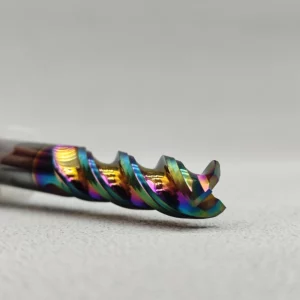Carbide end mills and high-speed steel (HSS) end mills are two common types of cutting tools used in machining operations. Both have their own unique characteristics and advantages, making them suitable for various applications. In this article, we will delve into the differences between carbide end mills and HSS end mills, exploring their composition, performance, and applications.
Carbide end mills are cutting tools made from tungsten carbide, a hard and durable material known for its resistance to wear and heat. They are widely used in CNC machining, milling, and drilling operations due to their superior performance and longevity. Carbide end mills typically consist of carbide inserts or solid carbide bodies with various cutting geometries tailored for specific machining tasks.
On the other hand, high-speed steel end mills are made from a type of tool steel known for its ability to withstand high temperatures without losing its hardness. While not as hard as carbide, HSS end mills offer good wear resistance and toughness, making them suitable for a wide range of machining applications. They are often preferred for general-purpose milling tasks and are more cost-effective than carbide end mills.
One of the key differences between carbide end mills and HSS end mills lies in their hardness and cutting performance. Carbide end mills are significantly harder than HSS end mills, allowing them to maintain sharp cutting edges and endure higher cutting speeds and feed rates. This results in faster machining times and improved productivity, especially when working with hard materials such as stainless steel, titanium, and hardened steels.
Moreover, carbide end mills exhibit superior wear resistance compared to HSS end mills, meaning they retain their cutting edges for longer periods, reducing the need for frequent tool changes and downtime. This characteristic is particularly advantageous in high-volume production environments where efficiency and cost-effectiveness are paramount.
In terms of applications, carbide end mills excel in demanding machining operations that require high precision, surface finish, and dimensional accuracy. They are commonly used in aerospace, automotive, and mold-making industries, where tight tolerances and intricate part geometries are critical. Carbide end mills are also preferred for machining abrasive materials and heat-resistant alloys due to their exceptional hardness and thermal stability.
On the contrary, HSS end mills are more versatile and suitable for a broader range of materials and machining tasks. They are often employed in light to medium-duty milling operations, such as milling soft metals, plastics, and wood, where high cutting speeds and feed rates are not necessarily required. Additionally, HSS end mills are easier to regrind and sharpen, making them a cost-effective choice for small-scale production and maintenance applications.
In conclusion, carbide end mills and high-speed steel end mills each have their own strengths and weaknesses, catering to different machining requirements and preferences. While carbide end mills offer superior hardness, wear resistance, and cutting performance, they come at a higher initial cost. On the other hand, HSS end mills provide versatility and cost-effectiveness, making them suitable for a wide range of machining applications.
